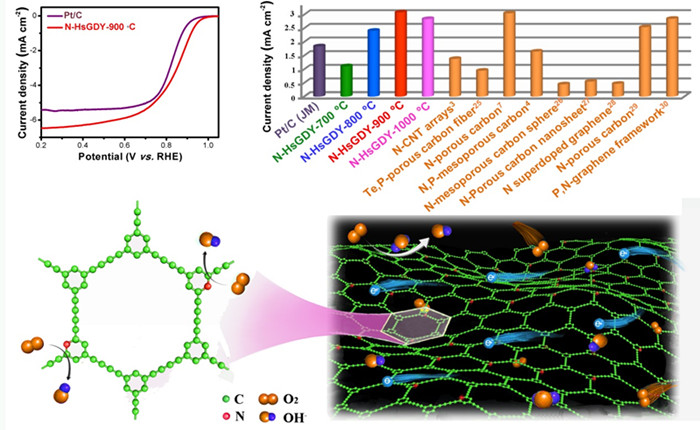To deal with common concerns about energy and the environment, much effort has been developed to produce new energy vehicles. As reported by Bloomberg NEF, about four million electric vehicles have been sold due 30 August of 2018 in the world.
Comparing with traditional cars, the most important component of an electric car is its battery system. Among these battery systems, the fuel cell is an ideal candidate with low pollution and high energy efficiency. However, the high cost of platinum based catalysts in fuel cells is a big obstruction for the commercialization.
To cure the above issues, theAdvanced Carbon for Renewable Energygroup from Qingdao Institute of Bioenergy and Bioprocess Technology (QIBEBT), Chinese Academy of Sciences (CAS) developed a new hydrogen substituted graphdiyne (HsGDY) material under the guidance of Prof. HUANG Changshui and LI Yuliang.
For HsGDY, three of the carbon atoms in a benzene ringare linked to acetylenic bonds, while the other three carbon atoms are linked to hydrogen (H) atoms. Accordingly, the C atoms linked to H are easily substituted by N atoms and act similarly to the carbon atoms at the edges or defects of graphene, allowing doping of pyridinic N at “in-plane sites” of the matrix, while maintaining the conjugated structure. Large molecular pores with a diameter of ca. 16.3 are distributed in the HsGDY framework plane, benefiting the mass transfer of O2. The as-synthesized pyridinic nitrogen-doped hydrogen-substituted graphdiyne shows much better electrocatalytic performance for the oxygen reduction reaction than that of the commercial platinum-based catalyst in alkaline media and comparable activity in acidic media. This study will open a different avenue for developing pyridinic N selectively doped carbon materials for fuel cells and other energy storage device.
The relevant work was published and highlighted byNature Communicaions. The research was supported by the National Natural Science Foundation of China, Frontier Science Research Project of the CAS, and the Natural Science Foundation of Shandong Province.

Figure 1. Pyridinic N doped HsGDY as efficient electrocatalysts for oxygen reduction reactions. (Image by LV Qing)
(Text by LV Qing)